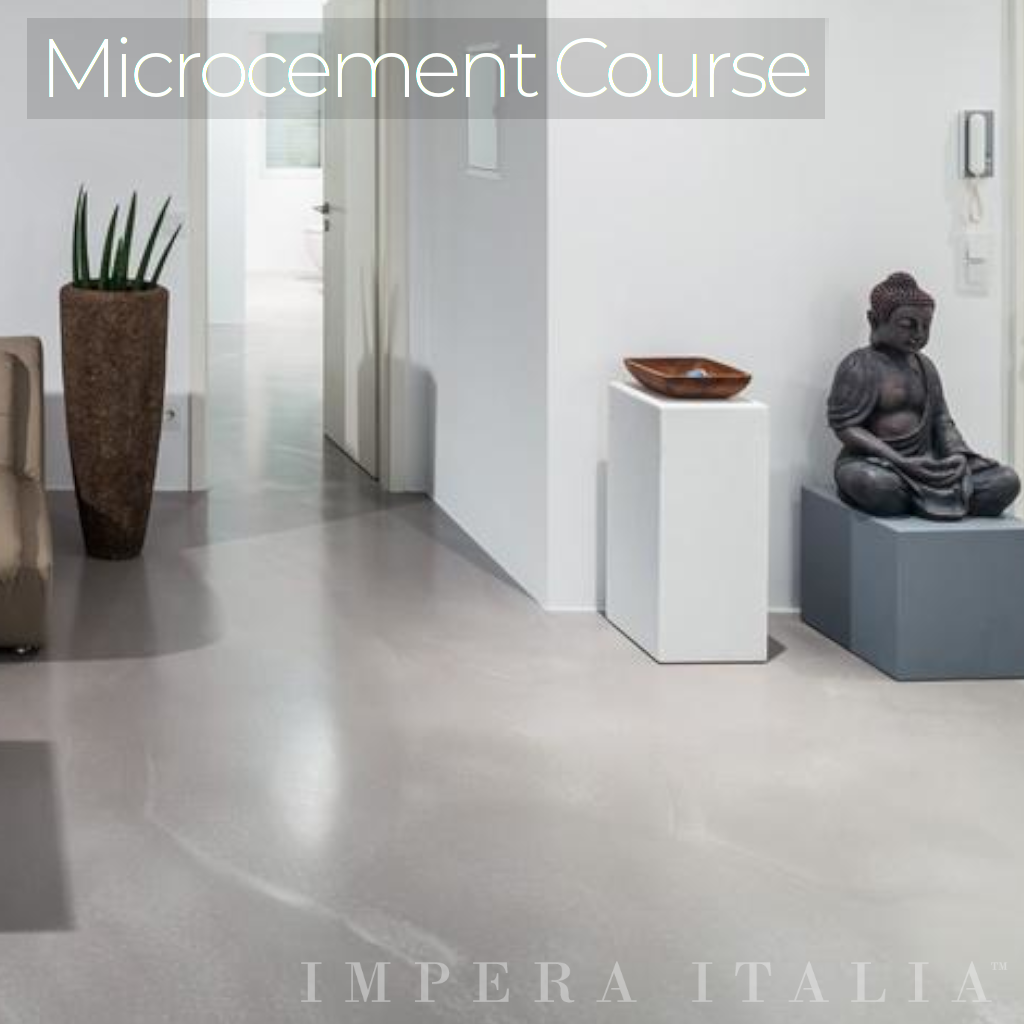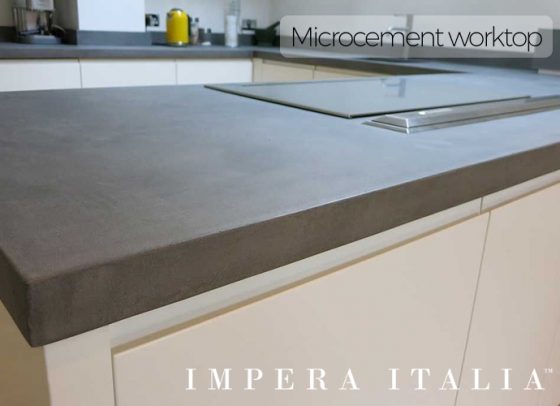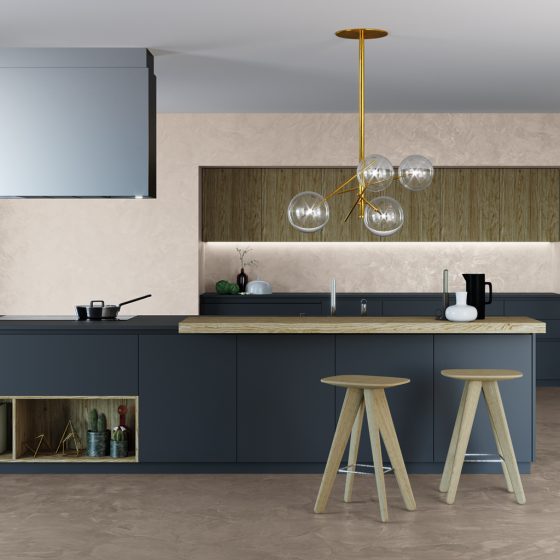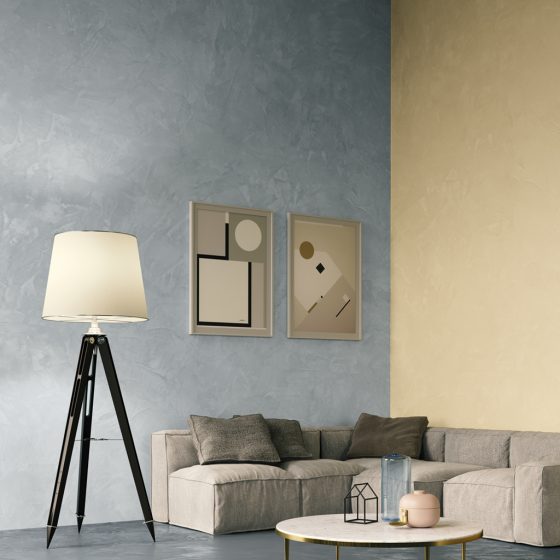Microcement is a modern resinous material that consists of a mix of resin and powder and is protected by a final coat of clear resin. It is part of the micro-surfacing systems family.
The history of microcement dates back to the 1950s when it was developed in the USA as an alternative to conventional concrete for flooring repairs on air carriers. They were looking for an easy-to-apply finish to repair existing concrete and polished concrete surfaces with a material that offers low permeability and high water resistance. The first installations were a success, and later on, they experimented with more complex resins (copolymers) and pigments to better match the concrete floors they were applied on.
The surfaces repaired with micro concrete proved to be long-lasting and flexible, making them suitable for a number of different applications, from high traffic areas to floors and walls of living areas. Microcement can be applied on existing surfaces like tiles to refurbish them, but can also be used for kitchen worktops or areas where applying cement or polished concrete would not be possible.
Microcement flooring systems were first commercialized in the US and European market in the ’70s, but it wasn’t until the late ’90s that they started to gain popularity. That is the time when microcement started to become popular as a cost-efficient, durable and easy-to-apply finish due to its quick dry time (less than 24h per coat) and simple application process. In the next couple of minutes, we are going to explain the benefits, cost and application of this fantastic product.

What are the benefits of microcement?
Microcement is tactile, seamless, easy to maintain and easy to clean. It can be used for floors, walls and bathrooms. The modern microcement kit by Impera Italia includes the primer (glue), micro cement base coat, decorative coats and top coat – all in one kit! Microcement is non-toxic and releases no concrete dust, which makes it very appealing not only for homes but also to schools, hotels and restaurants. Unlike concrete slabs, microcement is thin, only a couple of millimetres (3 to 3.5mm) thick.
Microcement by Impera Italia can be used for wet areas, stairs, floors and walls and even furniture, comes with a mesh and microcement base to prevent cracking and is available in different colours.
The following are the most important key benefits of micro cement:
Easy to apply – microcement can be applied by one or two people; it doesn’t require special tools or heavy machinery besides a trowel and a sander; wet microcement can be mixed and applied immediately and stays applicable for a couple of hours; microcement requires less labour and has a higher return on investment than poured concrete in commercial environments.
A huge variety of designs – interior designers, architects or even end-users can create a polished concrete-like design in areas that would not be able to take poured concrete. Microcement can be applied thinly and due to the handcrafted application, it can be customised to your requirements.
Durable – Generally micro-surfacing systems are extremely durable and flexible, resin-based finishes are even more so. They are hard and flexible at the same time and can last under frequent use if applied correctly!
Easy maintenance – microcement doesn’t need any special cleaning products just water and light detergents; microcement floor coatings or microcement worktops can be easily cleaned with little effort (although frequent cleaning is highly recommended)
Heat resistant – microcement worktops can withstand high temperatures up to 200°c as well as freezing temperatures; microcement is an excellent solution for hot areas, kitchens, pools or spas.
UV resistant – UV rays do not change or lighten the colour due to the inorganic pigments used to colour microcement.
Waterproof – microcement is a waterproof system that makes it perfect in bathrooms and even outdoor applications; microcement can withstand water exposure without being damaged or degraded by moisture. The Impera Italia resin coatings are very high quality and ensure that the microcement surface
Texture – microcement gives a nice tactile finish that can resemble the texture of wood, various stones, tadelakt or even bricks which brings aesthetics to any type of room i.e. living rooms, bedrooms etc.; microcement doesn’t need any special care when applied over existing tiles or walls as well as under-floor heating systems.
Easy to repair – microcement can be easily repaired; microcement repairs with the Impera Italia materials are almost invisible, allowing to extend product lifecycle.
Long-lasting – microcement flooring systems have a very long life cycle of about 50+ years;

How good is microcement?
Microcement has a fabulous finish that can be used to create a smooth finish or a textured look. Microcement, once the final coat is applied is highly scratch-resistant and can be easily repaired. It is a fantastic solution if you are looking for a surface that is seamless, microcement is incredibly versatile and can be used on walls and floors as well as countertops.
It is harder than marble but softer than some other, highly resinous materials. It needs to be cleaned and maintained like stone and although it is waterproof, the finished product should be treated as a stone or hardwood finish and should be re-protected from time to time if it is under heavy use.
Microcement is more flexible than a concrete slab, poured concrete or polished concrete but its waterproof nature (it does not absorb water at all when fully protected) means that it can be used in place of or on top of tiles.
Microcement always comes with a mesh to ensure no cracking occurs. The Impera Italia microcement kits come with everything you need to complete your microcement project from start to finish!

Why Is Microcement so expensive?
Costs for microcement is determined by a number of factors. Don’t be fooled by the price of a single bucket, you are going to need a system that includes the primer (glue), micro cement base, decorative coats and top coats! It also depends on the surfaces and many factors set by the applicator (site distance, availability, budget, design etc)
Generally speaking, costs of the material can vary substantially, depending on the size of the area, and the location (floor, walls or countertop) In contrast, the bigger the area the cheaper the material becomes. Very cheap, low-quality materials can be bought for as little as £10 per square metres, but the highest quality materials that can even be used for kitchen worktops start from £25.
Prices in London for a project start from £60 per square metre for a large floor and can be as much as £150+ per square metre for showers, single walls and worktops.
Is microcement more expensive than tiles?
Microcement isn’t more expensive than tiles, in fact, microcement is considerably cheaper than many large, natural or porcelain tiles. Always factor in the work the surface preparation, the loss due to the cutting and the labour, which can be immense if the tiles are of premium quality.
Also, the aesthetics are very different therefore it can be as difficult to compare microcement to tiles as comparing the latter to a concrete slab installation.
What is the difference between micro cement and polished concrete?
Polished concrete is an especially absorbent material and needs to be very thoroughly protected. Due to its thickness, it needs a significant floor depth and can not be applied on vertical areas. Polished concrete can only produce a smooth surface and does not have the look of modern microcement. It is also very labour and tool-intensive, requires grinding and sanding that can take a lot of time and effort.
Finally, polished concrete, as it is poured and then sanded, dries very slowly, generally a millimetre per day. This means that while microcement like other natural materials can be dry in a couple of days, polished concrete needs weeks or even months to dry.
Polished concrete, generally speaking, is also more expensive per square metre than microcement although, due to the density and thickness, it is more resistant.

Should I choose concrete floors or microcement?
Concrete floors can look great and are very functional, but microcement is the answer if you want to go for a seamless finish. Microcement can be used on almost any surface (floors, walls, countertops, existing tiles or even wood and metal) while concrete or cement can only be applied on floors. A microcement surface can come in almost any colour, can be applied in a bathroom and does not need the support or preparation of a concrete floor.
Choosing microcement means that you chose a dirt-resistant and waterproof surface that easily be re-done, repaired or modified.
Is microcement application difficult?
Microcement is a plaster based system which means that microcement can be applied by a professional renderer (as they generally work with multi-coated systems and mesh) or by very competent and trained DIYers. We offer a variety of training courses that ensure that the surface, once the final sealer is applied lasts, will remain seamless and beautiful.
Applying microcement to wood or furniture are the most difficult tasks. It can also be more difficult to apply micro cement in bathrooms when different finishes are required in different areas or when every room requires a different colour.
The way the plaster and sealer are applied can significantly affect the look of the surface therefore the better trained the applicator is the more control he has over the finish.
How do I maintain microcement?
Heavy objects should be moved carefully on microcement surfaces as they can mark them. To maintain microcement you should clean it regularly with a weaker, preferably eco-friendly detergent and should immediately wipe it when it gets in contact with ketchup, wine or any acidic material. This is due to the fact that no surface can be 100% protected when it is hand-applied and the applicator might miss some spots. Also, microcement is based on a natural, cementitious material therefore it does not evenly absorb the protector either and might have some imperfections.
The Impera Italia micro cement system
We are using a modern, thoroughly tested microcement, which is made of two components (a ready-mixed putty plaster and a binder powder) and is suitable for walls and floors of any room. The product is unique in that it offers easy repairs. quick application and fantastic flexibility. It can be applied by any trowel, but we recommend one of our wooden handle or Gold of Venice trowels as they do not leave any marks on the final coat.
Our thin microcement coating is suitable for any interior project, can even be applied on furniture and comes with a high-quality bi-component sealer.
If, for any reason you encounter any difficulties, please consult the manual and get in touch with our technical team via our contact form or over the phone!
Microcement Summary
Microcement is becoming an increasingly popular material in interior design. Homes and businesses seeking industrial interiors or concrete interiors now have the ability to have a modern, concrete-like look in places that could not be decorated with polished or poured concrete. Microcement is an ideal material when one wants a seamless surface, which is not only grout-free but also offers an outstanding contemporary design.
